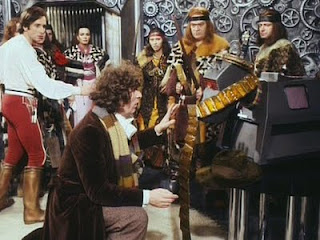
As I said when I started this feature, I’ve got a weakness for Gallifrey. I still think the show lost something when it was written out, and it’s hard to articulate just why. Its inhabitants are stuffy, the show’s production budget could never quite get the whole “super advanced space Rome” thing right, and the conventional wisdom holds that outside of THE DEADLY ASSASSIN, there are no really good stories set there.
THE INVASION OF TIME doesn’t quite disprove points one and two, but I’m willing to make the case that this is a better story than it gets credit for. The story, by “David Agnew” (a common pseudonym- Anthony Read and Graham Williams get the real credit), was a last minute replacement for a hideously expensive script involving cat people, and it has a certain loopy twistiness to it that’s hard not to enjoy. It’s a season finale, and on the old series, “season finale” doesn’t mean “epic blowout” so much as “we have no money left”, but despite being cheaper than usual, THE INVASION OF TIME has a nice atmosphere and gets quite a bit of entertainment value out of a supposedly bland concept.
After a meeting with some mysterious alien beings on board their spaceship, the Doctor decides, seemingly under their influence, to return to Gallifrey and assume the title of Lord President, which he won in DEADLY ASSASSIN’s emergency election and promptly forgot about. Taking the crown in a solemn, almost mystical ceremony, the Doctor is wounded by interfacing with the Matrix- the Gallifreyan repository of all knowledge- and goes into an even stranger state, exiling companion Leela (Louise Jameson) to the wilderness outside the main Citadel, and apparently opening the way for Gallifrey’s invasion by the still-enigmatic Vardans. The Doctor may be playing some kind of bluff, but then, the aliens have a game of their own.
There are more than a few reversals and surprises here, so I’m not sure how much to spoil off the bat. The Doctor himself is keeping us in the dark for over half the story, and though this wouldn’t be the only time, it’s rare for the show to even imply that he’s on the side of the baddies. We of course know this can’t be true, but Tom Baker does a good job selling the idea of the Doctor’s untrustworthiness. The story gains a certain energy from us never knowing what’s going on, which overcomes one of the common issues with six parters; the story rarely lags, because it’s always going someplace different. The structure isn’t exactly rock solid as a result, but it holds together.
The major stumbling block for this story, and the reason it doesn’t quite enjoy the reputation it should, is that even for DOCTOR WHO, the special effects were cheaper than cheap. The sets for Gallifrey- partly retained from DEADLY ASSASSIN- are impressive enough, but the President’s Office is apparently decorated with tire rims, the Vardans are represented for most of the story by shimmering pieces of foil, and a climactic chase through the TARDIS interior seems to have been mostly shot in an abandoned factory of some kind. Along with the cheap sets, our suspension of disbelief is sometimes tested by characters making asides to the camera, a sign of a sort of lazy self-awareness setting in.
Despite these limitations, the story speaks more to the ancient-yet-new mystery that Gallifrey is supposed to represent than most others. The sets and costumes still have a unique aesthetic quality, and the introduction of the “savages”- people who broke with the Time Lords and live in the Gallifreyan wilds outside their domed city- also reveals a fair bit about the civilization, without rendering it mundane. The Doctor’s coronation as Lord President is a wonderfully dramatic ceremony, conducted almost like a church service complete with organ music. (Topping it off, access to the Matrix is granted by a halo-like crown.)
We’ve also got some good character work, both from the regulars and the guests. The Doctor has always shunned authority, so when the story compels him to take it on, it’s an interesting exploration. This is also Leela’s last story, and Louise Jameson gets several great moments; the method by which she leaves seems sort of contrived, but she manages to sell it. Hilary Ryan also does a charming turn as Rodan, a Time Lord techie who serves almost as a sort of proto-Romana (though disappointingly, she destroys no Japanese cities in the course of the story.) We also have John Arnatt as the nicely crotchety Borusa, and Milton Johns as the slimy Castellan Kelner, who ingratiates himself to whoever is running Gallifrey at the moment.
As goofy as this story sometimes is, and as often as it seems that we have to use our imagination to figure out what the people making this really wanted it to look like, THE INVASION OF TIME has an incredible amount of charm. It knows it’s sort of a slapdash last-minute affair, and so tries to keep things fast and energetic to pave over any potential story holes or thematic inconsistencies. In that sense it shares a lot with some of the new series’ more madcap episodes, the ones that make serious fans grumble but pull massive approval figures regardless. Which just goes to show that Gallifrey wasn’t that stuffy a place after all.
Written by David Agnew (meaning Anthony Read & Graham Williams)
Produced by Graham Williams
Directed by Gerald Blake
Grade: A-
No comments:
Post a Comment